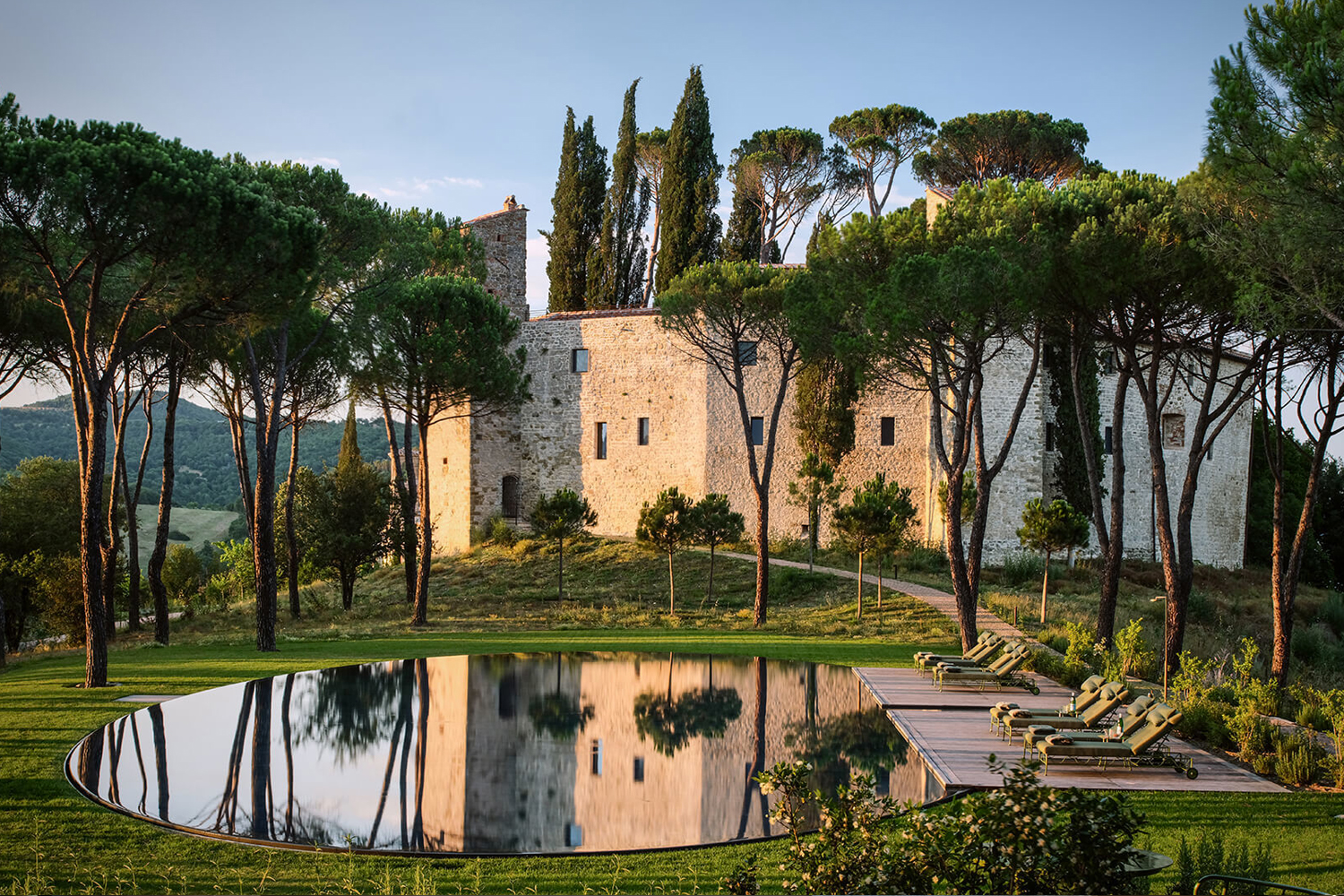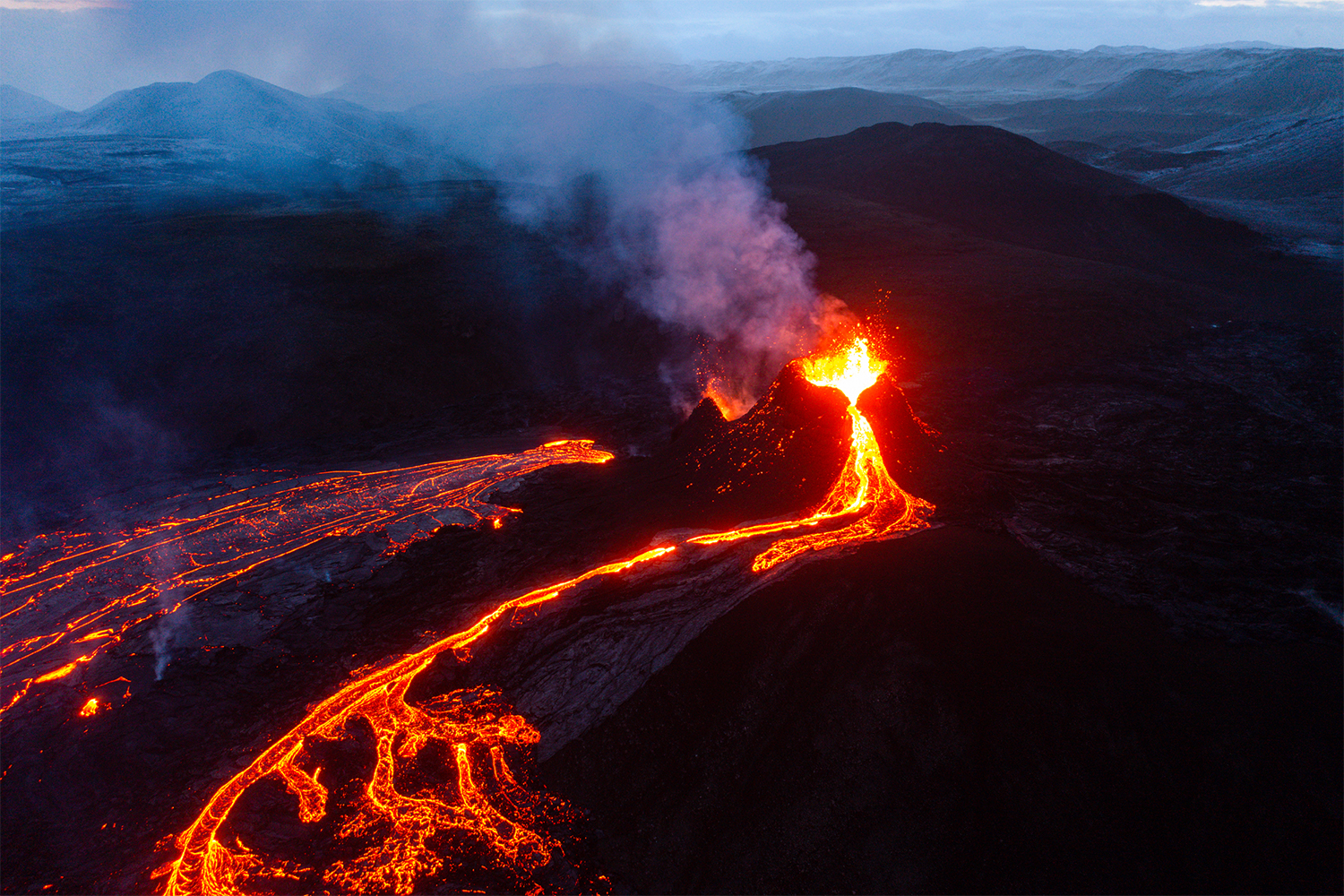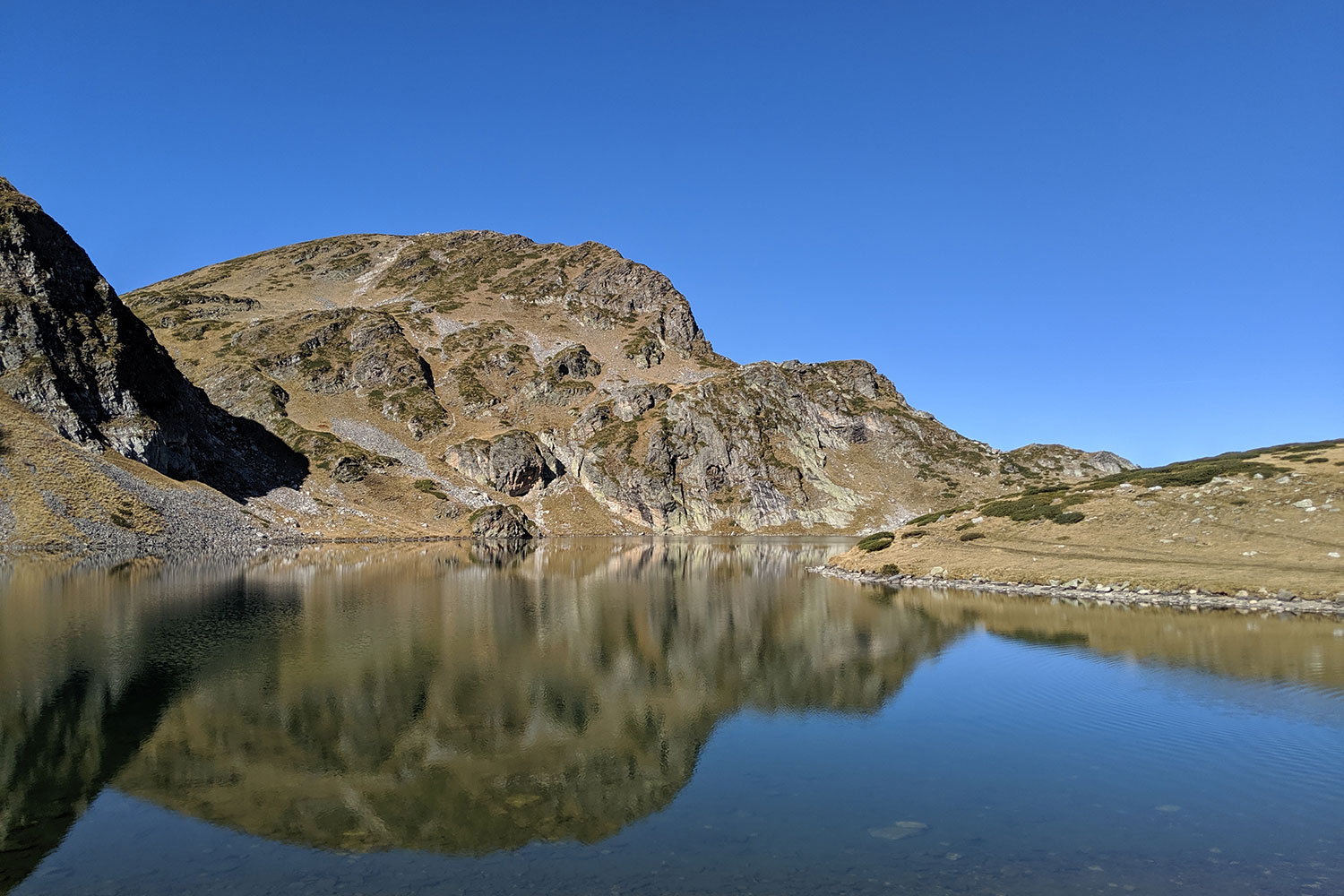My jet ski is toggling between 49 and 50 miles per hour, which is apparently when the speed limiter kicks in, despite my best attempts to circumvent it. I’ve just come shooting out from the town of Ólafsfjörður and its fjord of the same name, and am now coasting around one of the small fingertips of land that form the larger Tröllaskagi peninsula on the north coast of Iceland, and its larger, more-proper fjord, Eyjafjörður. To my right is a spectacular sheer cliff rising several hundred meters into the sky, with an abundant supply of waterfalls emptying straight into the abyss of the sea below, including the spectacular Mígandifoss.
There are arctic birds perched along the cliff and in the air, and seals in the water; one especially curious puffin flies just over my head and easily outpaces me before darting out of sight. I wouldn’t have believed it possible if my whale-watching guide the day before hadn’t already told me that puffins can achieve speeds of up to 60 miles per hour, belying their little roly-poly bodies and the fact that it takes them 10 seconds of skipping along the surface of the war before they’re even able to achieve flight at all.
Veering further from land, our group begins prowling the churning, frigid seas for dolphins or whales. Off in the distance, a few fins become visible, a mother and a few calves, and as we approach, a full pod of several dozen emerges. They swim up, under and around our jet skis and launch themselves into the air in majestic arcs, leaving me dumbfounded and chuckling like a madman. It appears the expedition led by Fairytale at Sea is delivering upon its name, and I realize that though it’s 6 p.m. and it should be getting close to dusk, we’re at the 66th parallel and it’s the end of June, so the midnight summer sun will never set, instead bouncing off the horizon like a giant basketball in slow motion and then rising once more.

It’s one of those life-affirming travel moments that people spend inordinate amounts of time and money trying to track down, and it was hardly even on my radar before I arrived in Iceland. I was ready for endless geothermal spas and hot springs, along with some all-hours nightlife in Reykjavik, and plenty of active volcano viewing, glacier gazing and waterfall watching. Even amid a pandemic reopening, and even in the absence of one of Iceland’s other chief attractions (the Northern Lights, which are only viewable in the eternal darkness of winter), the country has a staggering amount to offer travelers, making it easy to balance a luxurious getaway with all the action and adventure you can handle.
The day I arrived, Iceland lifted its curfew, allowing bars to stay open until 4 or 5 in the morning, and with the country’s vaccination program moving swiftly, masks are not to be seen anywhere in the country. And though in June I had to quarantine upon arrival in my hotel while I awaited the negative results of a COVID PCR test, as of July 1, vaccinated travelers from the U.S. can enter the country without the same obstacle. And with a number of airlines offering easy direct flights, if you’re itching to travel internationally, this is a destination you should absolutely be booking. Like now. And when you do, these are the spots to slot in at the very top of your itinerary.
Reykjavik and the South Coast
Reykjavik is home to the majority of Iceland’s population and its only international airport, so it’s the starting and ending point for any visit to the country. There is no shortage of accessible sites, from the unmistakable Hallgrímskirkja church reigning over the city from its hilltop position to the modernist Harpa concert hall, the metallic waterfront Sun Voyager statue and a number of museums specializing in everything from early Icelandic settlers to the Northern Lights and wonders of Iceland. The Apotek Hotel is a boutique property right in the heart of Reykjavik that makes for a smart and stylish stay.
Visit the newly opened Sky Lagoon for perhaps the world’s preeminent jet lag cure. I encourage a visit on the day of your arrival, perhaps straight from the airport if you have hours to kill before you can check into your hotel. The geothermal spa is a short 10- or 15-minute ride from city center, and offers a signature seven-step ritual that takes you from warm lagoon to cold plunge, hot sauna to body scrub, sweaty steam room to cleansing shower and back to the warm lagoon once again. The crucial eighth step, of course, is a drink, from the in-the-water bar or the comfortable lounge back indoors once you’re cleaned up.

While there are plenty of day trips and excursions you can take from Reykjavik while remaining based in the city, to spend your entire trip there is to do yourself a major disservice. The Blue Lagoon is on everyone’s must-hit list, and its milky blue waters, multi-step spa treatments and swim-up bar have clear appeal, even beyond their ubiquitous Instagramability. Staying there offers an entirely different experience though, and there are two sister properties offering their own take.
The first is the Silica Hotel, a sleek single-story property tucked into the black lava rocks and green moss of the Blue Lagoon’s surroundings. It features a private lagoon-style area that’s immediately accessible from the hotel lobby, while the Blue Lagoon itself is a 10-minute walk away down a short, meandering path. The rooms are plush and cozy, with neutral colors and clean, uncluttered design, inviting you to relax and indulge.
Then there’s The Retreat. When the hotel opened in April 2018 it was the first true five-star property in the country. After an eight-month COVID closure, The Retreat reopened its grand doors in early June 2021. Upon check-in you’ll be given a direct cell phone number to your personal host for the duration of your stay, and the lavish rooms feature large soaking tubs with generous views of the surroundings alongside perhaps the largest and most powerful rainfall shower I’ve seen in a hotel, as well as stocked, all-inclusive mini bars replete with wine and beer.
The Retreat’s signature restaurant is Moss (the Blue Lagoon’s main dining room is Lava; see the aforementioned reference to the area’s lava and moss surroundings), a multi-course extravaganza focused on utilizing Icelandic ingredients and specialties in new and inventive ways. During a recent visit options included a main five- or seven-course tasting menu with optional wine pairings, caviar and Champagne add-ons, and an alternate vegan tasting menu.
The property’s on-site spa also offers direct, private lagoon access, with an expansive set of different treatments and experiences running the gamut from cold shock to steam rooms and sauna chambers. There’s also a rooftop terrace from which you can view the main Blue Lagoon, which will give you a unique glimpse of just how large it is and how many people are there. Still, even when you’re in the thick of it, the steam rising from the water does a serviceable job of reducing your line of sight and making it seem more private than it is.
The Blue Lagoon and its hotels are a quick 15-minute jaunt to Fagradalsfjall, the active volcano currently in the midst of a months-long eruption. As you might expect with an expanding lava field, the areas you can safely access and how much of a view you may or may not get to enjoy are variable. Convenient daily printouts are available should you be staying at Silica or The Retreat, showing areas of lava, areas at risk, sites of visible eruptions and trails.
At the volcano access point, everything is well-marked and easy to manage, with a mile walk from the parking lot offering initial access, and another mile taking you deeper into the lava’s midst. While I visited on a foggy, rainy day and didn’t get to see any eruptions or breathtaking fast flows of molten lava on the surface, I did get to play the first literal game of the floor is lava in my life, walking overly freshly dried lava rock and peering down at the still scorching and very much alive and active lava below. Feeling the heat emanate from the ground and peering down to hear, feel and see a coursing, vibrant orange-red river of lava just a few feet underfoot more than satiated my day’s need for yet another Icelandic adrenaline rush.

Continuing to move east from Reykjavik and driving along the south coast for another 90 minutes gets you to another ideal base of operations, Hotel Rangá. Located in the town of Hella — need I say more? — Rangá puts you in direct proximity to an endless array of southern adventures. You could go scuba diving between glaciers or head out on a dune buggy ride with Southcoast Adventure to witness the ruined mountainside of Eyjafjallajökull, an infamous 2010 eruption that splashed across the rocky, flooded valleys of the glacial melt which it caused. Nearby is Katla, which locals fear: the volcano is overdue for an explosion and exceptionally more massive than its other active neighbors.
As for Rangá, while many hotels in the country skew toward the modern Scandi style, this place plays up its countryside location with wooden furniture and décor that are more evocative of a ski chalet or hunting lodge. Its seven suites are thematically styled around the flora and fauna of the different continents, offering a rustic American cabin meets the Icelandic wilderness aesthetic. The on-site restaurant features specialties such as reindeer carpaccio and salmon sourced from the river flowing through the property, while the bar puts to use locally made Icelandic spirits in a number of inviting cocktails.
Tear yourself away from the multiple on-site hot tubs for a short drive up the coast to Vik’s black sand beaches, a visit to the man-made Caves of Hella, which theoretically touts evidence of the settlement of Irish monks half a millennia in advance of the Vikings, and the region’s storied waterfalls. Skógafoss is one of the country’s largest and most visited, and while you can walk straight up to its base, a 400-step climb to the top offers a rewarding view. Visitors to Seljalandsfoss can walk behind the fall for a unique perspective as wet and wonderful as it sounds. The fall is part of a complex in the immediate vicinity, including Gljúfrabúi, located a short walk away. Both Skógafoss and Seljalandsfoss are visible as you drive past on the ring road, and I dare any first time traveler to see them and not be compelled to make a stop, planned or otherwise.

Exploring Iceland’s North and West
More and more travelers to Iceland are eager to drive around the entire ring road. For a shorter but still immersive itinerary, you can hop a short domestic flight to the country’s northern gateway, Akureyri. You can, and should, still opt to rent a car and drive from there, but perhaps without the need to circumnavigate the whole island and live out of an RV or camper for 10 nights. Iceland has a number of thematic driving routes, with the official tourism board, Visit Iceland, recommending options that include the Golden Circle in the south and the Arctic Coast Way along the northern coast. Also from the north, you can access the Diamond Circle, a route that’ll bring you inland to two of the country’s most epic waterfalls, Goðafoss (Godafoss) and Dettifoss, among other notable sites.
Akureyri is a short drive away from Húsavík, the town famous for its whale watching, but perhaps even more famous now for the Will Ferrell and Rachel McAdams Netflix comedy, Eurovision Song Contest — “Where the whales can live ’cause they’re gentle people, in my hometown, my hometown …” Come for the whales (via an operator such as Gentle Giants), but stay for attractions like the Geosea geothermal sea baths, offering a killer view and an expansive spa area consisting of pools with several different temperature zones, along with the requisite extras such as a steam room and in-water bar access.
For a homey, personal touch while in the north, consider a stay at the Grenivík Guesthouse, a cozy four-room guest house built by local resident Ingólfur Kr. Ásgeirsson. You’ll eat his grandmother’s legendary pastries at breakfast and be regaled with his tales and tips. While in the west, meanwhile, you might want to rest your head at the Hotel Varmaland, located in a connected series of renovated school buildings joined by the modern addition of a rooftop restaurant and bar boasting floor-to-ceiling windows and an expansive view of the local region.
The Sigló Hótel is well known for its pierside outdoor spa tubs along the water’s edge in Siglufjörður; if you couldn’t tell by now, hot springs, saunas and spas are very much a key part or the Icelandic experience, regardless of when you visit or where exactly you opt to head. Also in the north, you may want to stop into Bjórböðin, the Beer Spa, where you’ll bathe in a sudsy beer bath while sipping from a fresh keg of beer within arm’s reach.

As you make your way west and south back towards the capital region, Krauma is another spa worth a stop. Located and powered by the adjacent Deildartunguhver, the most powerful hot spring in Europe, the sleek spa features pools at five different temperatures along with fireside relaxation rooms, cold plunge tubs and steam rooms, and a restaurant showcasing local ingredients. Much of the charcuterie, for instance, comes from neighboring producer Haafell, the only dedicated goat farm in the country, which has not only helped save certain rare breeds from extinction, but also created a whole new agricultural and culinary pipeline for the country.
All of this, of course, only scratches the surface of what Iceland has to offer. I could list another 10 foss I’d recommend for you to photograph, or any number of other hot springs, geologic formations and activities. But Iceland is a choose-your-own-adventure destination, and the adventure is perhaps best chosen individually rather than fully prescribed.
As you venture across the country, perhaps sliding perilously on steep and curvy mountain passes, avoiding what’s commonly touted as the most dangerous animal in Iceland (the sheep; they love nothing more than jumping in front of foreigner’s rental cars, and outnumber Iceland’s human population by a solid margin), powering through dark single-lane tunnels with two-way traffic, jumping into frigid Arctic waters or stepping across recently dried lava, it behooves you to remember the local wisdom imparted to me by an affable Reykjavik taxi driver named Gunnar: “We have a saying here that it’s all going to take care of itself. Or, basically: fuck it!”
For more travel news, tips and inspo, sign up for InsideHook's weekly travel newsletter, The Journey.





















